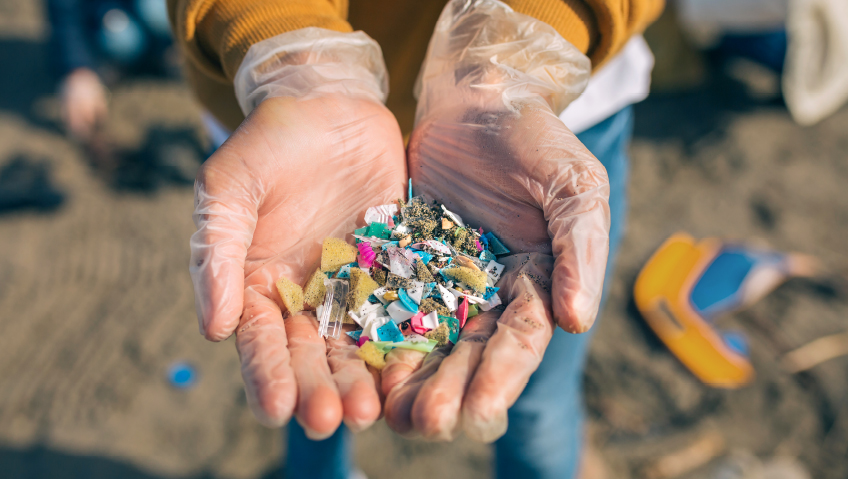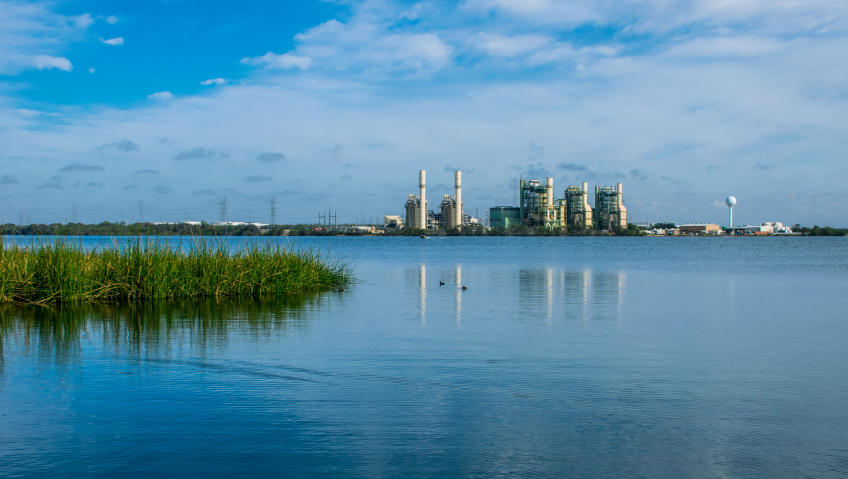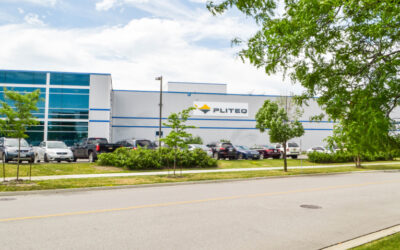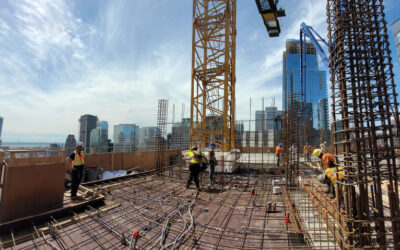Looking at the future of plastic, especially its use as aggregate or filler in concrete, one is reminded of Paul Hawken’s book, The Ecology of Commerce. Here, he says that in nature, all waste equals food. Considering that, on a planet comprising delicate ecosystems where there really is no such thing as “away” in terms of waste, recycling plastics by adding them to concrete could become a double-edged sword, given sufficient time. By inconsiderately adding plastic aggregates to concrete mixtures, thinking it a solution, we shelve the pollution problem, but only until building rubble is released into the environment—now in the form of carbon-emitting Portland cement and micro- and nanoplastics.
Based on the premise that humans are a part of nature rather than apart from nature, this form of pollution is an important consideration for the future of humans, let alone the planet. Recent research shows that the accumulation of microplastics in the form of beads, foam, fragments, and fibers within the human organism introduced through food and exposure to pollution poses potential autoimmunity and neurotoxicity risks that are well worth taking seriously, as described by the National Library of Medicine. For this reason, if plastic could become food in some way, its use in construction could start making a lot more sense than it currently does. And by turning plastic into food, I do not refer to food containing nanoparticles entering breast milk or produce, as has been described by The Guardian.
Instead, what if plastic could become edible for some critter, turning it into a benign force to benefit our natural habitat? Micro- and nanoplastics are two of our biggest problems because, until recently, at least, they were virtually indestructible due to the power of the polymer chains that hold their structures together. But perhaps not for much longer.
The BBC recently reported the formulation of a self-destructing plastic that could be a game-changer for good. Han Sol Kim, of the University of California San Diego, La Jolla, is one of the researchers who helped develop the new plastic by genetically engineering the naturally occurring bacterium, Bacillus subtilis, to survive at increased temperatures while captured within a plastic matrix. Not only does the bacterium add to the material’s strength, but it remains inactive during the lifespan of the plastic—until exposed to organic environments like soil or decomposing plant materials.
Despite such discoveries, the most common verdict about plastic fabrication remains working toward a global future where it is significantly reduced, as the United Nations’ recent Canadian plastic treaty talks reflected. Within that context, this new science promises additional hope. Imagine a world where whatever historic plastic remains in our ecosystems is cleared, and safe and secure bio-destruction of all waste material becomes the norm. Easier said than done, one might say.
Yet, if Hawken’s premise is anything to go by, businesses hold the real power to deliver such change. “The promise of business is to increase the general well-being of humankind through service, a creative invention and ethical philosophy. Making money is, on its own terms, totally meaningless, an insufficient pursuit for the complex and decaying world we live in,” he writes, highlighting how restorative economies can save our environment.
True to this sentiment, research on other bacteria and enzymes that could safely turn plastic into food continues. In February 2023, Science Direct reported new research suggesting a bacterium from the intestinal tract of the larvae of the lesser wax moth, Achroia grisella, could be another possible solution to polyethylene destruction. Another possibility is Ideonella sakaiensis, a bacterium that Japanese scientists discovered is naturally occurring and consumes plastic back in 2016. Even more fascinating is that this bacterium, which adapted to its littered environment, is a picky eater with a preference for food packaging, namely polyethylene terephthalate, or PET.
While none of these organisms are realistic plastic-busting solutions at present, the concrete industry and the world live in hope thanks to ongoing research and development. Add to that the considerable money and research that is going into carbon sequestration by trapping greenhouse gases in limestone which is then added to concrete—thereby removing it permanently from the atmosphere—and it is clear that materials scientists are working around the clock to find real solutions to make the future a safer, healthier place.
It is against this backdrop of solving the core plastic pollution issue that one considers the growing trend of adding plastic to concrete as an aggregate and its possible future effects on the environment. While its efficacy is undisputed—in some cases even claiming to outperform conventional concrete—the reality remains that it will likely re-enter the ecosystem at some point.
One possible solution to the plastics problem is voided biaxial slabs. This concrete displacement and partial replacement method reduces the volume of concrete—and, as a result, carbon emissions—poured into large structures. In addition, compared to high-volume plastic aggregates, the method reduces the volume of plastic that goes into a structure. Engineered plastic bubbles are structurally hollow orbs secured inside metal cages, spread across concrete zones on foundation slabs of buildings ranging from single to multiple storeys.
There is also a plastic- and concrete-free material to consider, namely Earth-friendly concrete (EFC) developed by Australian company, Wagners. Containing ground, granulated blast furnace slag, sand, fly ash, water, and gravel, this geopolymer gets its name from its acid activation mechanism and reduces the carbon footprint of any building by over 70 percent due to its zero Portland cement content. The company claims that if concrete construction could be compared to a country, it would be third in line for being the top carbon contributor.
More recently, American company, C-Create Technologies, introduced zeolite- and basalt-based alternatives, free of Portland cement, that aim to provide built structures with greatly reduced and even negative emissions levels. Announcing its first basalt-mixture application in March of this year, the product is as new as it is exciting. Based in San Leandro, California, this materials science product developer at the forefront of North American concrete development was founded by Dr. Rouzbeh Savary, PhD, an alumnus of the Massachusetts Institute of Technology. A recipient of a long list of awards, including recognition by the federal Department of Energy, the company’s future is promising.
Another exciting team is Geopolymer International, which presented the world’s largest 3D Geocement printer, a first for North America according to the company, at World of Concrete 2024, held in Las Vegas, Nevada earlier this year. The machine is loaded with a geopolymer comprising polymerized silicate that renders a granite-like result claimed to last for millennia; exhibits more than four times the strength of old-fashioned concrete; performs exceptionally well in the ocean; is acid-, water-, and fire-resistant; and is fully printable given the right equipment.
The first house of this kind was erected in the Las Vegas desert in 2023 with a greater than 79 percent reduction in carbon emissions over a traditional building its size. The product aims to mitigate and remove all the negative aspects typical of Portland cement from the construction equation, advertising that it does not use water in its mixture. This is significant in comparison to traditional concrete mixtures that are typically tremendously thirsty. In the long term, the material also results in reduced construction and demolition waste, as the buildings from geopolymers last so much longer. In addition, recycled Portland cement-based rubble can be incorporated into its geopolymer mixtures, keeping it out of the soil.
In addition to these new materials is the groundbreaking work being done by companies like Heirloom, which operates “the first Direct Air Capture (DAC) facility in the United States to permanently remove CO2 from the atmosphere, fulfilling customer carbon removal purchases in Tracy, California. The only challenges remain funding and scalability—areas where business, as Hawken points out, can lend tremendous support to the natural environment. To this end, Heirloom follows the intelligence of the planet, which is known for using rocks as carbon sinks (defined as any substance that absorbs more carbon than it emits, including oceans, soil, and foliage).
Therefore, until suitable plastic-consuming agents can be sufficiently scaled, commercialized, and perhaps even incorporated in concrete mixtures to deal with the existing plastic overload of the planet, the United Nations’ drive for plastic reduction remains imperative and deserving of the industry’s support. Until this is achieved, finding alternative ways of extending concrete and its production while not contributing to future environmental problems is of the essence.
Apart from reducing the use of Portland cement, remaining aware of the dangers of releasing more micro- and nanoplastics into the environment and mitigating and avoiding further contamination through plastic’s use in building materials may, ultimately, be the safest and most genuinely Earth-friendly approach available in concrete right now. If a culture of cross-pollination across technologies and industries is developed, leading to their wise and wary use, neo-concretes may yet become one of our mutual future’s biggest saving graces.













